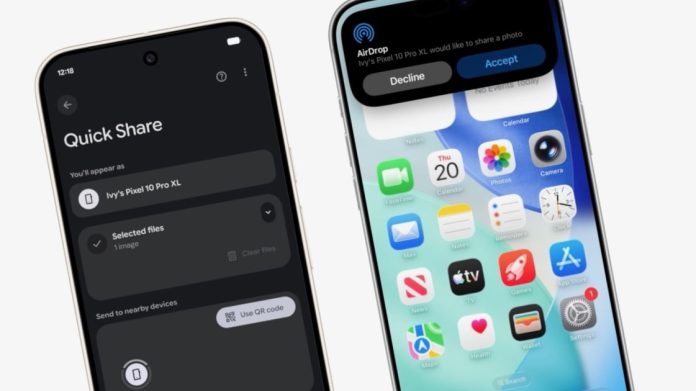AirDrop has long been exclusive to Apple devices, but Google has created a way for Android phones to tap into the file-sharing function.
Coming first to Pixel 10 phones, the feature uses Google’s competing solution for Android, Quick Share, to connect to Apple’s AirDrop. A Pixel 10 can then send videos, photos, and other files to a nearby iPhone, despite the different operating systems. “We’ve heard from many people that they want a simpler way to share files between devices,” Google says.
A demo video from Google shows a Pixel 10 using the Quick Share menu to wirelessly send an image to a nearby iPhone, which receives the picture through AirDrop. The iPhone then sends a separate image back to the Pixel 10, apparently over the same connection.
This Tweet is currently unavailable. It might be loading or has been removed.
In a separate blog post, Google added: “We’ve made Quick Share interoperable with AirDrop, allowing for two-way file sharing between Android and iOS devices.”
The catch is that the interoperability requires the iPhone to set AirDrop to “Everyone for 10 Minutes” in order to receive the file from a nearby Pixel 10. In contrast, many iPhone users likely have their AirDrop function set to receive files from “Contacts Only.”
We’ll be curious to see if Apple reacts in any way. Google’s blog post notes that “we welcome the opportunity to work with Apple to enable ‘Contacts Only’ mode in the future,” which suggests the iPhone maker didn’t give its blessing.
Apple didn’t immediately respond to a request for comment. But we wouldn’t be surprised if Apple tries to crack down, and views the interoperability as a potential security threat.
Apple didn’t take too kindly to a developer creating an app that brought iMessage to Android in 2023, for example. But Google is a much bigger foe, and has not shied away from criticizing Apple’s walled-garden approach, most notably with its campaign to get Apple to adopt RCS messaging technology. (Apple finally relented on that last year.)
Recommended by Our Editors
Perhaps in response, Google’s blog post says it designed the interoperability through rigorous security testing and built-in safeguards. “The communication channel itself is hardened by our use of Rust to develop this feature. This memory-safe language is the industry benchmark for building secure systems and provides confidence that the connection is protected against buffer overflow attacks and other common vulnerabilities,” Google adds.
All file-transfer requests also require user approval. “This feature does not use a workaround; the connection is direct and peer-to-peer, meaning your data is never routed through a server, shared content is never logged, and no extra data is shared,” Google added.
There’s no word on when the feature will expand to other Android phones. But Google describes the function as “just the first step as we work to improve the experience and expand it to more devices.”

Get Our Best Stories!
A Smart, Bold Take on the Wireless World
Thanks for signing up!
Your subscription has been confirmed. Keep an eye on your inbox!
About Our Expert

Michael Kan
Senior Reporter
Experience
I’ve been a journalist for over 15 years. I got my start as a schools and cities reporter in Kansas City and joined PCMag in 2017, where I cover satellite internet services, cybersecurity, PC hardware, and more. I’m currently based in San Francisco, but previously spent over five years in China, covering the country’s technology sector.
Since 2020, I’ve covered the launch and explosive growth of SpaceX’s Starlink satellite internet service, writing 600+ stories on availability and feature launches, but also the regulatory battles over the expansion of satellite constellations, fights with rival providers like AST SpaceMobile and Amazon, and the effort to expand into satellite-based mobile service. I’ve combed through FCC filings for the latest news and driven to remote corners of California to test Starlink’s cellular service.
I also cover cyber threats, from ransomware gangs to the emergence of AI-based malware. Earlier this year, the FTC forced Avast to pay consumers $16.5 million for secretly harvesting and selling their personal information to third-party clients, as revealed in my joint investigation with Motherboard.
I also cover the PC graphics card market. Pandemic-era shortages led me to camp out in front of a Best Buy to get an RTX 3000. I’m now following how President Trump’s tariffs will affect the industry. I’m always eager to learn more, so please jump in the comments with feedback and send me tips.








